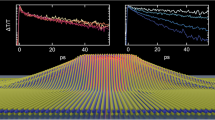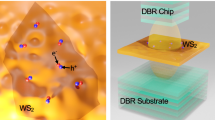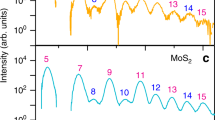Abstract
Monolayer semiconductors are an emerging platform for strong nonlinear light–matter interactions that are enhanced by the giant oscillator strength of tightly bound excitons. Little attention has been paid to the impact of excitonic resonances on the temporal dynamics of such nonlinearities, since harmonic generation and optical wave mixing are generally considered instantaneous processes. We find that a significant time difference, ranging from −40 to +120 fs, is necessary between two light pulses for optimal sum-frequency generation (SFG) and four-wave mixing (FWM) to occur from monolayer WSe2 when one of the pulses is in resonance with an excitonic transition. These resonances involve both band-edge A excitons and high-lying excitons that comprise electrons from conduction bands far above the bandgap. Numerical simulations in the density-matrix formalism rationalize the distinct dynamics of SFG and FWM. The interpulse delays for maximal SFG and FWM are governed primarily by the lifetime of the one-photon and two-photon resonant states, respectively. The method therefore offers an unconventional probe of the dynamics of excitonic states accessible with either one-photon or two-photon transitions. Remarkably, the longest delay times occur at the lowest excitation powers, indicating a strong nonlinearity that offers exploration potential for excitonic quantum nonlinear optics.
This is a preview of subscription content, access via your institution
Access options
Access Nature and 54 other Nature Portfolio journals
Get Nature+, our best-value online-access subscription
$29.99 / 30 days
cancel any time
Subscribe to this journal
Receive 12 print issues and online access
$209.00 per year
only $17.42 per issue
Buy this article
- Purchase on Springer Link
- Instant access to full article PDF
Prices may be subject to local taxes which are calculated during checkout





Similar content being viewed by others
Data availability
Any additional data are available from the corresponding authors upon reasonable request. Source data are provided with this paper.
Code availability
The Mathematica code used for the numerical simulations discussed in this paper is available from the corresponding authors upon reasonable request.
References
Shen, Y. R. The Principles of Nonlinear Optics (Wiley, 1984).
Boyd, R. W. Nonlinear Optics 3rd edn (Academic, 2008).
Keller, U. Recent developments in compact ultrafast lasers. Nature 424, 831–838 (2003).
Garmire, E. Nonlinear optics in daily life. Opt. Express 21, 30532–30544 (2013).
Mukamel, S. Principles of Nonlinear Optical Spectroscopy (Oxford University Press, 1999).
Cundiff, S. T. & Mukamel, S. Optical multidimensional coherent spectroscopy. Phys. Today 66, 44–49 (2013).
Autere, A. et al. Nonlinear optics with 2D layered materials. Adv. Mater. 30, 1705963 (2018).
Schneider, C. et al. Two-dimensional semiconductors in the regime of strong light–matter coupling. Nat. Commun. 9, 2695 (2018).
Langer, F. et al. Lightwave valleytronics in a monolayer of tungsten diselenide. Nature 557, 76–80 (2018).
Liu, H. et al. High-harmonic generation from an atomically thin semiconductor. Nat. Phys. 13, 262–265 (2017).
You, J. W., Bongu, S. R., Bao, Q. & Panoiu, N. C. Nonlinear optical properties and applications of 2D materials: theoretical and experimental aspects. Nanophotonics 8, 63–97 (2019).
Wang, G. et al. Colloquium: Excitons in atomically thin transition metal dichalcogenides. Rev. Mod. Phys. 90, 021001 (2018).
Liu, G.-B. et al. Electronic structures and theoretical modelling of two-dimensional group-VIB transition metal dichalcogenides. Chem. Soc. Rev. 44, 2643–2663 (2015).
Mak, K. F. & Shan, J. Photonics and optoelectronics of 2D semiconductor transition metal dichalcogenides. Nat. Photonics 10, 216–226 (2016).
Lafeta, L. et al. Second- and third-order optical susceptibilities across excitons states in 2D monolayer transition metal dichalcogenides. 2D Mater. 8, 035010 (2021).
Hernandez-Rueda, J., Noordam, M. L., Komen, I. & Kuipers, L. Nonlinear optical response of a WS2 monolayer at room temperature upon multicolor laser excitation. ACS Photonics 8, 550–556 (2021).
Wang, G. et al. Giant enhancement of the optical second-harmonic emission of WSe2 monolayers by laser excitation at exciton resonances. Phys. Rev. Lett. 114, 097403 (2015).
Yao, K. et al. Continuous wave sum frequency generation and imaging of monolayer and heterobilayer two-dimensional semiconductors. ACS Nano 14, 708–714 (2020).
Lin, K.-Q. et al. Narrow-band high-lying excitons with negative-mass electrons in monolayer WSe2. Nat. Commun. 12, 5500 (2021).
Lin, K.-Q., Bange, S. & Lupton, J. M. Quantum interference in second-harmonic generation from monolayer WSe2. Nat. Phys. 15, 242–246 (2019).
Fleischhauer, M., Imamoglu, A. & Marangos, J. P. Electromagnetically induced transparency: optics in coherent media. Rev. Mod. Phys. 77, 633–673 (2005).
Phillips, M. C. et al. Electromagnetically induced transparency in semiconductors via biexciton coherence. Phys. Rev. Lett. 91, 183602 (2003).
Kim, D.-S. et al. Unusually slow temporal evolution of femtosecond four-wave-mixing signals in intrinsic GaAs quantum wells: direct evidence for the dominance of interaction effects. Phys. Rev. Lett. 69, 2725–2728 (1992).
Saiki, T., Kuwata-Gonokami, M., Matsusue, T. & Sakaki, H. Photon echo induced by two-exciton coherence in a GaAs quantum well. Phys. Rev. B 49, 7817–7820 (1994).
Trovatello, C. et al. Optical parametric amplification by monolayer transition metal dichalcogenides. Nat. Photonics 15, 6–10 (2021).
Dai, Y. et al. Electrical control of interband resonant nonlinear optics in monolayer MoS2. ACS Nano 14, 8442–8448 (2020).
Liu, S. et al. An all-dielectric metasurface as a broadband optical frequency mixer. Nat. Commun. 9, 2507 (2018).
Poellmann, C. et al. Resonant internal quantum transitions and femtosecond radiative decay of excitons in monolayer WSe2. Nat. Mater. 14, 889–893 (2015).
Moody, G. et al. Intrinsic homogeneous linewidth and broadening mechanisms of excitons in monolayer transition metal dichalcogenides. Nat. Commun. 6, 8315 (2015).
Cundiff, S. T. et al. Rabi flopping in semiconductors. Phys. Rev. Lett. 73, 1178–1181 (1994).
Cadiz, F. et al. Excitonic linewidth approaching the homogeneous limit in MoS2-based van der Waals heterostructures. Phys. Rev. X 7, 021026 (2017).
Martin, E. W. et al. Encapsulation narrows and preserves the excitonic homogeneous linewidth of exfoliated monolayer MoSe2. Phys. Rev. Appl. 14, 021002 (2020).
Fang, H. H. et al. Control of the exciton radiative lifetime in van der Waals heterostructures. Phys. Rev. Lett. 123, 067401 (2019).
Chang, D. E., Vuletić, V. & Lukin, M. D. Quantum nonlinear optics — photon by photon. Nat. Photonics 8, 685–694 (2014).
Wild, D. S., Shahmoon, E., Yelin, S. F. & Lukin, M. D. Quantum nonlinear optics in atomically thin materials. Phys. Rev. Lett. 121, 123606 (2018).
Sun, D. et al. Observation of rapid exciton–exciton annihilation in monolayer molybdenum disulfide. Nano Lett. 14, 5625–5629 (2014).
Castellanos-Gomez, A. et al. Deterministic transfer of two-dimensional materials by all-dry viscoelastic stamping. 2D Mater. 1, 011002 (2014).
Kim, K. et al. van der Waals heterostructures with high accuracy rotational alignment. Nano Lett. 16, 1989–1995 (2016).
Acknowledgements
We thank C. Schüller and R. Huber for insightful discussions. Financial support is gratefully acknowledged from the Deutsche Forschungsgemeinschaft (DFG, German Research Foundation) SFB 1277 (project-ID 314695032) projects B03 (J.M.L. and S.B.) and B11 (K.-Q.L.), SPP 2244 (project-ID LI 3725/1-1, 443378379) (K.-Q.L. and S.B.) and from DFG project number 439215932 (J.M.L.). Growth of the hBN crystals was supported by the Elemental Strategy Initiative conducted by the MEXT, Japan (grant number JPMXP0112101001) and JSPS KAKENHI (grant numbers 19H05790 and JP20H00354).
Author information
Authors and Affiliations
Contributions
K.-Q.L. conceived and supervised the project. J.M.B., L.C., P.W., K.-Q.L. and S.B. carried out the experiments and simulations. S.B. wrote the simulation code. K.W. and T.T. provided the hBN crystals. All authors analysed the data, discussed the results and contributed to the writing of the manuscript.
Corresponding author
Ethics declarations
Competing interests
The authors declare no competing interests.
Peer review
Peer review information
Nature Photonics thanks Giulio Cerullo and Christoph Lienau for their contribution to the peer review of this work.
Additional information
Publisher’s note Springer Nature remains neutral with regard to jurisdictional claims in published maps and institutional affiliations.
Supplementary information
Supplementary Information
Supplementary Notes 1 and 2, Figs. 1–9 and Table 1.
Source data
Source Data Fig. 1
Original data for the plots.
Source Data Fig. 2
Original data for the plots.
Source Data Fig. 3
Original data for the plots.
Source Data Fig. 4
Original data for the plots.
Source Data Fig. 5
Original data for the plots.
Rights and permissions
Springer Nature or its licensor holds exclusive rights to this article under a publishing agreement with the author(s) or other rightsholder(s); author self-archiving of the accepted manuscript version of this article is solely governed by the terms of such publishing agreement and applicable law.
About this article
Cite this article
Bauer, J.M., Chen, L., Wilhelm, P. et al. Excitonic resonances control the temporal dynamics of nonlinear optical wave mixing in monolayer semiconductors. Nat. Photon. 16, 777–783 (2022). https://doi.org/10.1038/s41566-022-01080-1
Received:
Accepted:
Published:
Issue Date:
DOI: https://doi.org/10.1038/s41566-022-01080-1
This article is cited by
-
Nonlinear optics of two-dimensional heterostructures
Frontiers of Physics (2024)



